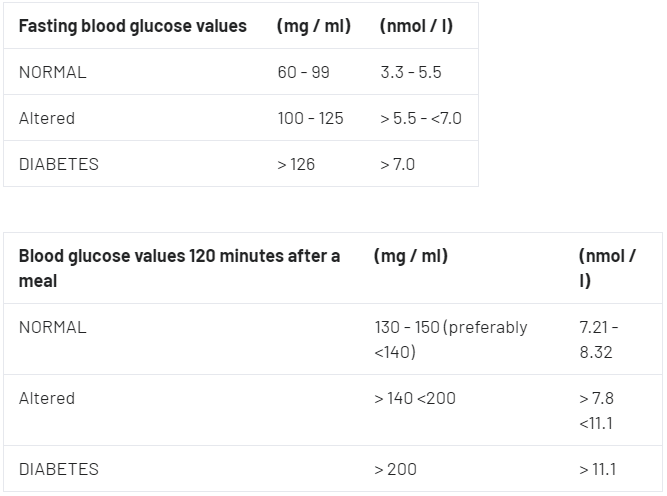
Generality
Lower your blood sugar is a necessity that concerns people with high levels of glucose in the blood, to avert the dangerous consequences of a condition known as hyperglycemia.
Typical of diabetes mellitus, hyperglycemia is responsible for characteristic symptoms, including dry mouth, intense thirst, abdominal pain with vomiting, breathless acetone-smelling, progressive alteration of consciousness, etc.
How to lower blood sugar, i.e. strategies to reduce glucose levels (clearly when they have an anomaly), has always been a very popular topic, which includes: diet, exercise, healthy behavioral habits, etc.
A brief review of blood glucose and its values when fasting and after a meal
Expressed in milligrams per deciliter (mg/dl) or in nanomoles per liter (nmol / l), blood sugar is the concentration of glucose — a sugar — in the blood.
In healthy people, the fasting blood sugar value is between 60 and 99 mg/ml, while the blood sugar level after a meal can settle between 130 and 150 mg/ml (much depends on the sugar content of the meal taken).
The most well-known disease associated with blood glucose — namely high blood sugar ( hyperglycemia ) — is diabetes.

Lower your blood sugar
Lowering blood glucose is an act of fundamental importance to avoid the dreaded complications, both acute and chronic, linked to excessively high levels of glucose in the blood (hyperglycemia).
Lowering blood sugar and the knowledge of how to lower blood sugar are two primary needs among diabetic patients, whose body produces insufficient quantities of the hormone insulin and/or is poorly sensitive to the action of the aforementioned hormone.
Curiosity
During the day, blood sugar is not stable but varies in relation to the meals an individual consumes, the quantity and quality of the food ingested during the aforementioned meals, and physical activity.
How to recognize the need to lower blood sugar?
Having ascertained under what circumstances it is appropriate to lower blood sugar, it remains to be clarified how to notice these circumstances. The characteristic symptoms of hyperglycemia, fundamental to the recognition of the latter, when it is in progress, are:
- Dry mouth and intense thirst;
- Pain in abdominal vomiting;
- Weak and rapid pulse;
- Red, dry and hot skin
- Breath with the characteristic smell of acetone;
- Progressive alteration of consciousness, with the appearance of restlessness, agitation, and confusion.
The most serious consequences of hyperglycemia (in medical jargon, we speak of hyperglycemic crisis ) are hyperglycemic coma (or diabetic coma ), extreme dehydration due to hyperosmotic urine from hyperglycemia, and thrombosis (on which an increased risk depends on stroke, heart attack, etc.).
IDENTIFYING A SUBDLE ENEMY: Mild Hyperglycemia
Due to poorly defined symptoms, limited hyperglycemia can go unnoticed for a long time. This is why diabetes experts recommend periodically monitoring blood glucose levels also through practical portable blood glucose meters, capable of detecting the latter through the prick of a fingertip.
Under the strict control and indications of a doctor, glycemic self-control can be useful in personalizing drug therapy in relation to the actual needs of the body, which may vary, for example, according to the level of physical activity or the type of power supply.
How to lower your blood sugar
Considering the considerable difficulties in summarizing the numerous strategies relating to how to lower blood sugar within a single article, only the most common remedies are listed below — such as physical activity, dietary interventions, behavioral interventions, etc.
PHYSICAL ACTIVITY: HOW DOES IT ACT ON GLUCOSE?
Exercising is one of the simplest and most effective remedies for lowering blood sugar.
If at rest the muscle tissue uses insulin as a transport vehicle to absorb glucose from the blood, during intense physical activity the same muscle tissue is able to capture blood glucose (i.e. that present in the blood) even in the absence/deficiency of the aforementioned hormone; this happens because physical exercise, especially the duration one, stimulates the displacement (in technical jargon, we speak of translocation) of glucose uptake molecules — the so-called glucose transporters GLUT-4 — from the storage site, present inside of muscle cells, to the plasma membrane of the latter.
In other words, physical activity triggers a process whereby the cells of the muscle tissues move a group of molecules capable of capturing blood glucose from the internal storage site (where they have no contact with the blood and the glucose circulating there) to the plasma membrane (which is the portion of a cell used for contacts and communication with other cells, blood, the extracellular environment, etc.).
In this way, the muscle cells “arm” themselves externally with a sort of “glucose-catching net”, which allows them not to use insulin. Clearly, the glucose that muscle cells take from the blood in this way is accompanied by a reduction in blood sugar.

























0 comments:
Post a Comment